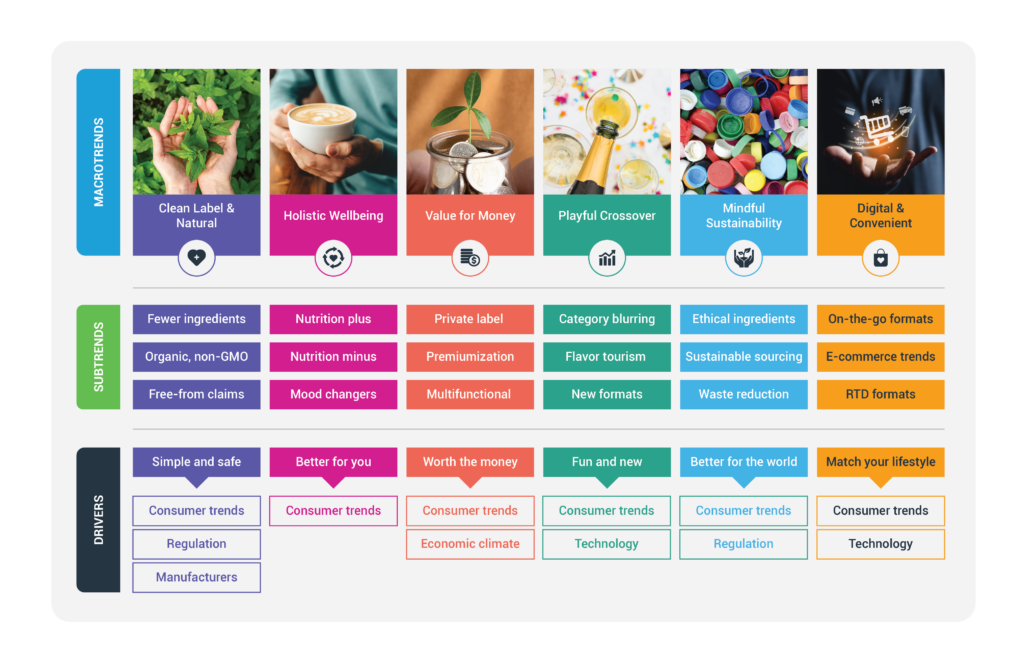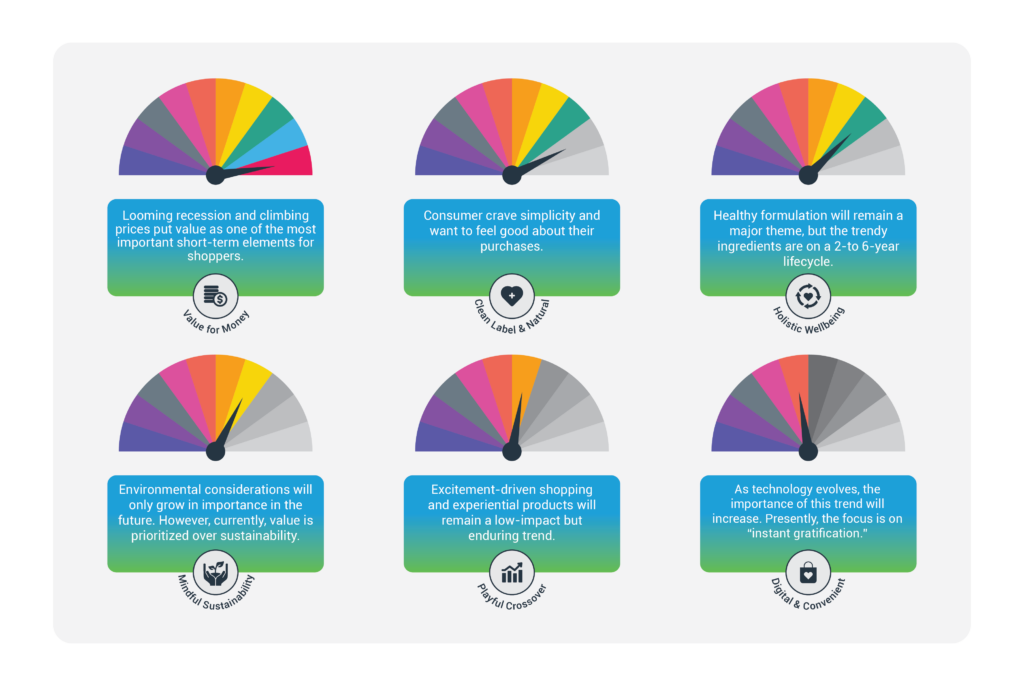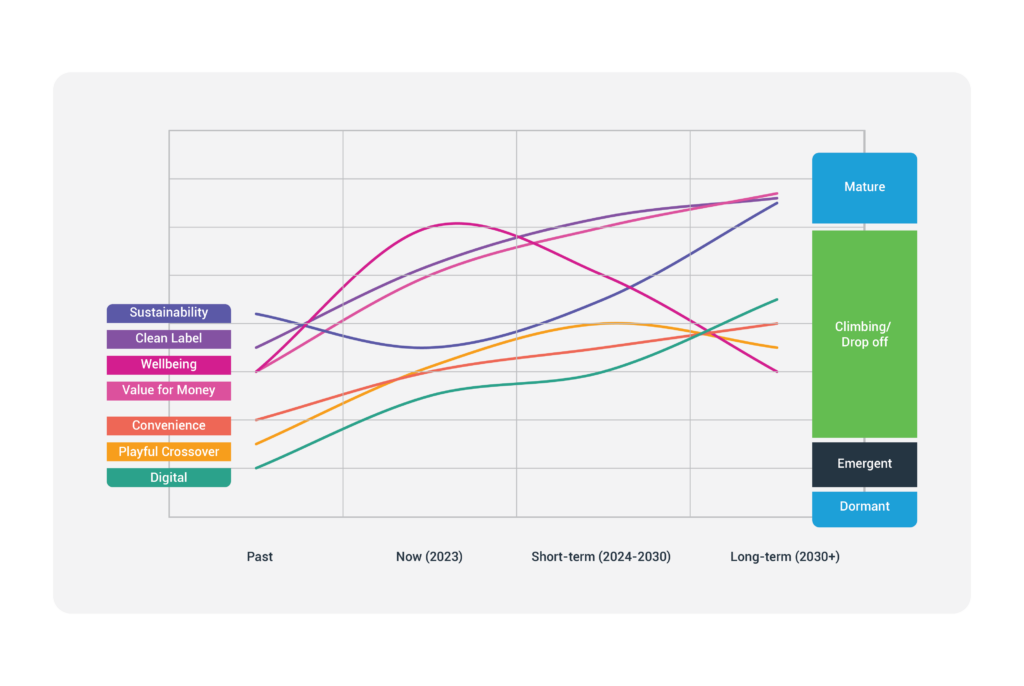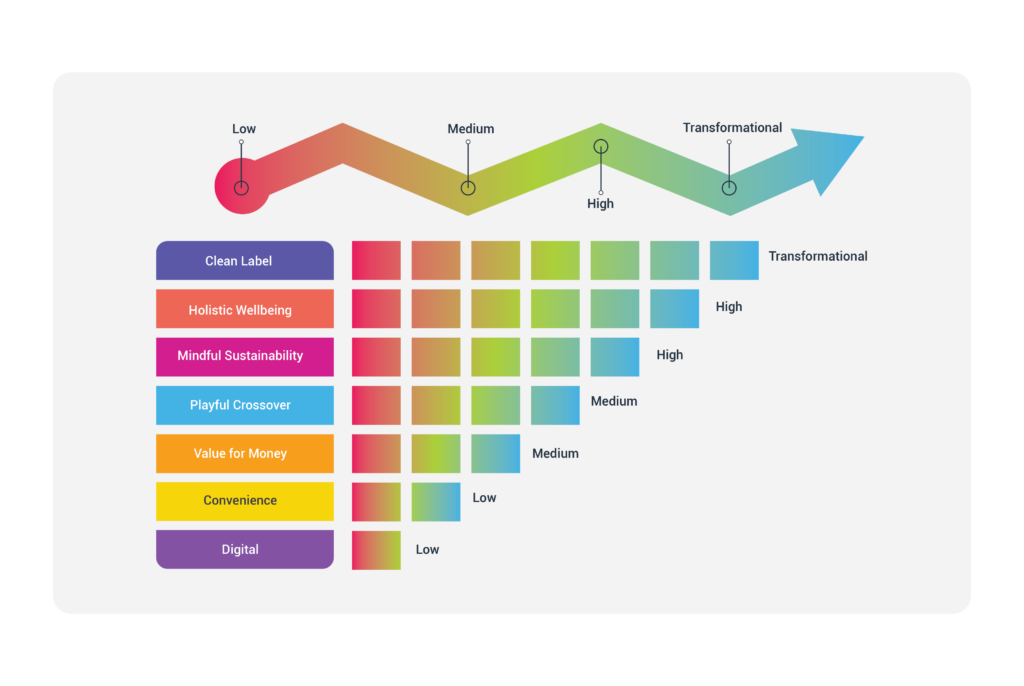As the food and nutrition industry gears up to converge once again in Geneva for this year’s Vitafoods Europe event, I’m preparing for several exciting presentations and dialogs, not least a panel discussion at the Future of Nutrition Summit on May 13 on the topic of: New Product Development Strategies for Next-Gen Consumers.
Alongside experts in the industry from leading companies including Holland & Barrett, Huel, and Mondelez, it is bound to be a timely discussion, given that understanding consumer behavior is paramount for businesses striving to stay competitive in today’s dynamic food and beverage industry. From shifting preferences in ingredient choices to evolving health-conscious trends, consumer behavior and market trends shape the trajectory of product development.
In this article, we will explore how the development of macrotrends is influencing consumer behavior in the food and beverage landscape and impacting the ingredients business.

Macrotrends in Consumer Behavior
Consumer preferences are multifaceted and are influenced by various macrotrends that reflect broader societal values and evolving lifestyles. Let’s explore these trends in detail:
- Clean Label and Natural:
Clean-label and natural products have witnessed a surge in demand as consumers increasingly prioritize transparency and authenticity in their food and beverage choices. This trend has prompted manufacturers to reformulate their products, opting for simpler ingredient lists and incorporating natural alternatives to artificial additives and preservatives.
Consumer prioritization: High priority, as consumers crave simplicity and seek products that align with their values
- Holistic Wellbeing:
Holistic wellbeing comprises a comprehensive approach to health, encompassing physical, mental, and emotional wellness. Consumers, particularly younger demographics, are prioritizing proactive health management and seeking products that support their overall wellbeing. This trend has significant implications for ingredient usage, driving demand for functional foods and beverages that offer nutritional benefits beyond basic sustenance.
Consumer prioritization: High priority, as consumers prioritize proactive health management and longevity
- Value for Money:
Despite the emphasis on health and wellness, value for money remains a crucial consideration for consumers, especially amidst economic uncertainties. Consumers seek products that provide both quality and affordability, influencing ingredient choices and formulation strategies. However, as the market evolves, the importance of value for money is expected to shift relative to other trends.
Consumer prioritization: High priority, particularly amidst economic challenges
- Playful Crossover:
The intersection of fun and creativity with food and beverage products has captivated consumers, particularly younger demographics seeking novel and experiential offerings. While this trend may have a shorter lifespan compared to others, it has a medium impact on ingredient usage, driving innovation in product development and marketing strategies.
Consumer prioritization: Medium priority, as consumers seek novelty and excitement in their food experiences
- Mindful Sustainability:
Sustainability has emerged as a defining factor in consumer purchasing decisions, with growing awareness of environmental issues driving demand for eco-friendly products and practices. From ethically sourced ingredients to recyclable packaging, consumers prioritize brands that demonstrate a commitment to sustainability, influencing ingredient choices and supply chain practices.
Consumer prioritization: Medium priority, with increasing importance over time as environmental concerns become more prominent
- Digital and Convenient:
The proliferation of digital technologies has revolutionized the way consumers interact with food and beverage brands, offering convenience and accessibility through online platforms and mobile apps. While digital and convenient shopping experiences are important considerations, their impact on ingredient usage is moderate compared to other trends, focusing more on distribution channels and consumer engagement strategies.
Consumer prioritization: Medium priority, driven by the need for convenience in today’s fast-paced world

Evolution of Trends Over Time
Over time, consumer trends evolve and shift, and we expect to see changes in the short- and long-term prioritization of these trends.

- Value for money peaking: As economic conditions fluctuate, the importance of value for money reaches its zenith, with consumers prioritizing budget-friendly options to stretch their dollars further. However, as economic stability returns, this trend is expected to wane in significance, making way for other priorities.
- Clean label, sustainability, and wellbeing rising: Looking toward the horizon, we see clean labels, sustainability, and wellbeing emerging as the reigning champions of consumer preferences in the long term. As awareness of health and environmental issues grows, consumers are placing greater emphasis on products that align with their values and contribute to their overall wellbeing.
- Short-term trends: Playful crossover and digital convenience trends are expected to remain influential in the short term, catering to consumers’ desire for novelty and convenience. However, their impact may diminish over time as consumer priorities continue to evolve.

Impact of Trends on Ingredients
The ripple effects of consumer trends extend beyond the surface in determining the ingredients that food and beverage products are formulated with. Here’s how these trends are influencing ingredient selection and formulation:
- Clean label revolution: Demand for clean-label products is driving a transformation in the sourcing and formulation of ingredients. Manufacturers are reformulating recipes to reduce the size of ingredient lists and incorporate natural, recognizable ingredients that resonate with consumers.
- Sustainability in action: As consumers become more eco-conscious, brands are exploring sustainable ingredient options that minimize environmental impact and promote ethical sourcing practices. From regenerative agriculture to upcycled ingredients, sustainability is becoming a driving force in ingredient innovation.
- Functional food revolution: The rise in holistic wellbeing is fueling innovation in functional ingredients that offer tangible health benefits beyond basic nutrition. From superfoods to adaptogens, consumers seek out ingredients that support their physical, mental, and emotional wellness.
- Playful innovation: Playful crossover products are inspiring creativity in ingredient selection, encouraging brands to experiment with unique flavor combinations and novel ingredients that capture consumers’ imagination. From exotic fruits to artisanal spices, ingredient innovation knows no bounds in the pursuit of culinary delight.
Implications for Food and Beverage Manufacturers:
Manufacturers must navigate the complexities of consumer behavior and market trends to remain competitive in the food and beverage landscape. By staying attuned to macrotrends and emerging health considerations, businesses can:
- Tailor product formulations to align with consumer preferences for clean-label, natural ingredients, along with functional benefits
- Invest in sustainable practices and ingredient sourcing to meet the growing demand for eco-conscious products
- Embrace innovation in formulation technologies to enhance product quality, efficacy, and consumer appeal
Conclusion:
Consumer behavior in the food and beverage industry is shaped by a myriad of factors, from macrotrends to emerging health concerns. By understanding these dynamics and adapting to changing consumer preferences, businesses can position themselves for success in the ever-evolving marketplace. With a focus on innovation, sustainability, and consumer-centric strategies, manufacturers can navigate the complexities of consumer behavior and drive growth in the food, beverage, and nutrition industries.
Engage With Us:
As we explore the evolving landscape of consumer behavior in the food and beverage industry, we invite you to join us at Vitafoods Europe Future of Nutrition Summit to share your insights and perspectives. How do you see these trends shaping the future of the industry? What considerations do you prioritize when making new product development decisions in food and beverage? Join the conversation, and let’s continue to navigate this dynamic landscape together.
Take Action:
Are you a food and beverage manufacturer looking to stay ahead of consumer trends and drive innovation in your product offerings? Take the first step by partnering with Kline & Company to gain a deeper understanding of the impact of these B2C trends on ingredients and the B2B market. Contact us today to explore how we can help you meet the evolving demands of the market and achieve sustainable growth.

